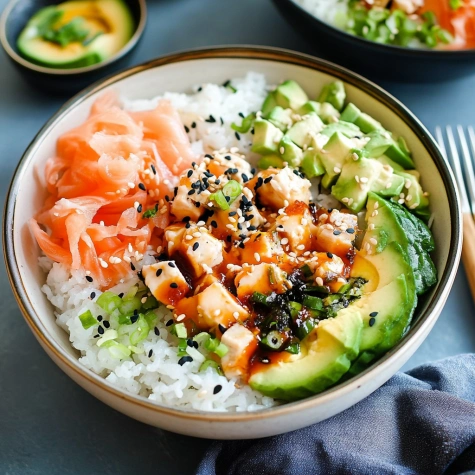 Pin it
Pin it
Imagine the delightful flavors of a California roll transformed into a convenient, customizable bowl. These California Roll Sushi Bowls deliver all the beloved tastes of the classic sushi roll without requiring any rolling skills or special equipment. The fluffy sushi rice forms the perfect base for imitation crab, fresh cucumber, creamy avocado, and a drizzle of spicy mayo—creating a satisfying meal that's both impressive and surprisingly simple to prepare.
I served these sushi bowls at my last family gathering, and even my sushi-skeptical father-in-law went back for seconds. The beauty of these bowls is how the textures complement each other—crunchy cucumbers, soft rice, and buttery avocado create a perfect harmony in every bite.
Ingredients
- Sushi rice or calrose rice: The foundation of any good sushi dish, short-grain rice provides the perfect sticky consistency. Look for bags labeled "sushi rice" or "calrose rice" for authentic results.
- Rice vinegar: Gives the rice its distinct tangy flavor. Be sure to use rice vinegar specifically, not regular distilled vinegar, as the flavor profile is much different.
- Sugar and salt: These balance the vinegar's acidity and enhance the rice's flavor. Regular granulated sugar works perfectly.
- Mayonnaise: Creates the creamy base for the spicy sauce. Light mayonnaise works well, but regular provides a richer flavor.
- Sriracha: Adds that signature spicy kick. Adjust according to your heat preference.
- Soy sauce: Provides the essential umami flavor. Low-sodium varieties allow you to better control the salt level.
- Imitation crab or lump crabmeat: The star protein—imitation crab (surimi) is budget-friendly and widely available, but fresh lump crabmeat elevates the dish for special occasions.
- English cucumber: Offers refreshing crunch and moisture. English varieties have fewer seeds and thinner skin, making them ideal.
- Matchstick carrots: Adds color, crunch, and subtle sweetness. Pre-cut carrots save time, but freshly julienned work beautifully too.
- Nori sheet: Provides that authentic ocean flavor essential to sushi. Look for toasted sheets in the international section.
- Pickled sushi ginger: Adds bright, palate-cleansing notes. The pink pickled variety is slightly sweeter than fresh ginger.
- Avocado: Contributes essential creaminess. Choose slightly firm avocados that yield gently to pressure for perfect texture.
- Sesame seeds: Offer subtle nutty flavor and visual appeal. The mix of black and white creates beautiful contrast.
Step-by-Step Instructions
- Step 1:
- Place your 2 cups of sushi rice in a fine mesh strainer and rinse thoroughly under cold running water. This step is absolutely crucial—continue rinsing while gently agitating the rice with your fingers until the water runs completely clear, which typically takes about 2 full minutes. This removes excess starch that would make your rice gummy. Once rinsed, give the strainer several firm taps against your palm to remove excess water. The rice should be well-drained but still moist.
- Step 2:
- Transfer the rinsed rice to a medium saucepan and add exactly 2¼ cups of water. Precision matters here for perfect texture. Bring the mixture to a full, rolling boil over medium-high heat, then immediately reduce to low heat and cover with a tight-fitting lid. Allow the rice to simmer for exactly 15 minutes without lifting the lid—this creates the steam necessary for proper cooking. After 15 minutes, remove from heat but keep covered, allowing the rice to steam and finish cooking for an additional 10 minutes.
- Step 3:
- While the rice is cooking, prepare your seasoning mixture. In a small saucepan, combine 4 tablespoons of rice vinegar with 2 tablespoons of granulated sugar and ½ teaspoon of salt. Heat this mixture over medium heat, whisking continuously until the sugar completely dissolves—about 2-3 minutes. Remove from heat and let cool slightly. Once the rice has finished its 10-minute rest, pour the vinegar mixture evenly over the rice. Using a large wooden or plastic spoon (metal can damage the rice), gently fold the seasonings into the rice with a cutting motion, being careful not to mash or compact the grains.
- Step 4:
- In a small mixing bowl, combine ¼ cup of mayonnaise with 1½ tablespoons of sriracha, adjusting proportions to your preferred level of spiciness. Whisk until completely smooth and uniform in color. Transfer this vibrant orange sauce to a small ziplock bag, pressing it toward one corner for easy drizzling later. Set aside at room temperature.
- Step 5:
- In another small bowl, whisk together ¼ cup of low-sodium soy sauce with the remaining 1 tablespoon of rice vinegar until well combined. This simple mixture adds essential umami depth and balances the richness of the other components. Set aside at room temperature.
- Step 6:
- In a large mixing bowl, gently toss together the 10 ounces of imitation crab (torn into bite-sized pieces), 1½ cups diced cucumber, ¾ cup chopped carrots, crumbled nori sheet, 1½ tablespoons of pickled ginger, and the diced avocado. Alternatively, for a more visually striking presentation, keep ingredients separate and arrange them in distinct sections atop the rice—this creates the beautiful "deconstructed sushi" look that's perfect for photos.
- Step 7:
- Divide the prepared seasoned rice among 4-5 serving bowls, creating an even base layer. If you've mixed your toppings, spoon the colorful mixture evenly over each portion of rice. If using the separated approach, artfully arrange each component in its own section atop the rice, creating a colorful pattern.
- Step 8:
- Drizzle each bowl with the soy sauce mixture, distributing it evenly. Snip a tiny corner from your bag of spicy mayo and artistically drizzle it across the top of each bowl. Sprinkle with black and toasted sesame seeds for visual appeal and subtle nutty flavor. Serve immediately to enjoy optimal freshness and texture, particularly of the avocado.
 Pin it
Pin it
My mother never appreciated sushi until I introduced her to these bowls. She particularly loves the cucumber—crisp, hydrating, and full of silica for healthy skin. At 75, she claims these bowls are her beauty secret, and honestly, looking at her glowing complexion, I'm starting to believe her!
Perfect Rice Every Time
Achieving the ideal sushi rice texture can make or break this dish. The rinsing process might seem tedious, but it's absolutely essential for removing excess starch that would otherwise make your rice gummy and unpleasant. I've found that using my fingertips to gently agitate the rice while rinsing helps speed up the process. Water temperature matters too—cold water prevents the rice from beginning to cook during rinsing, preserving its ideal structure. Let your rice rest after cooking with the lid still on—this final steaming step allows the moisture to distribute evenly throughout all the grains, resulting in that perfect sticky-but-distinct texture that's the hallmark of great sushi rice.
Make-Ahead Tips & Storage
These bowls are surprisingly versatile for meal prep with a few strategic adjustments. Prepare all components separately and store in individual containers—the seasoned rice, toppings (except avocado), and sauces can all be refrigerated for up to three days. The critical step is keeping the avocado separate and cutting it fresh just before serving to prevent browning. For maximum crispness, I also recommend storing the cucumber separately. When ready to eat, gently reheat the rice with a splash of water in the microwave, covered with a damp paper towel to restore its texture. Assembling just before eating ensures each component maintains its ideal texture and flavor profile, making this a realistic option for busy weeknight dinners.
 Pin it
Pin it
Creative Variations
Don't feel limited by traditional California roll ingredients—this versatile format welcomes endless customization. For a spicy tuna version, substitute finely diced raw sashimi-grade tuna mixed with additional sriracha for the imitation crab. Vegetarians can replace the seafood with thinly sliced tofu marinated in soy sauce and rice vinegar, or cubes of ripe mango for a tropical twist. Salmon lovers might add thin slices of smoked or cured salmon atop the rice before the other toppings. For extra texture, consider adding crispy tempura flakes, which provide a satisfying crunch against the soft rice. My personal favorite variation includes paper-thin radish slices and microgreens on top, adding peppery notes and visual interest that elevates this humble bowl to restaurant quality.
Frequently Asked Questions
- → Can I use real crab instead of imitation crab?
Yes, you can use lump crabmeat or any fresh cooked crab for a more authentic flavor. Just ensure it is properly shredded or chopped into small, bite-sized pieces.
- → How do I avoid overcooking the sushi rice?
Use the correct water-to-rice ratio, cook on low heat, and allow the rice to steam with the lid on after cooking for proper absorption and fluffiness.
- → What can I substitute for mayonnaise in the sriracha sauce?
For a lighter option, substitute mayonnaise with Greek yogurt or opt for vegan mayonnaise for a plant-based alternative.
- → Can I prepare the ingredients in advance?
Yes, you can prep the sushi rice, sauce, and chopped vegetables ahead of time. Assemble the bowls just before serving to keep the ingredients fresh.
- → What are some additional toppings I can add?
You can customize the bowls with additional toppings like sliced radishes, edamame, pickled vegetables, or extra toasted sesame seeds for added texture and flavors.
